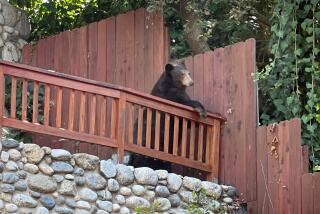Squirrels have overrun some coastal cities and lost their fear of humans, officials say

Population booms when people feed the animals.
- Share via
Ground squirrels are having their way across the San Diego County coast, despite the best efforts of city and state parks officials to reduce their numbers.
“I almost tripped over a few, and one tried to join me here at the picnic table,” said Kevin Braasch, a visitor from Chicago who had just sat down near Tamarack Avenue in Carlsbad after a two-mile jog from his hotel. “They sure are friendly creatures.”
A little too friendly, most people would say. The squirrel population is booming at the beach, so much so that the animals have lost their fear of humans. They scamper right up to people, usually looking for a handout.
But don’t feed the animals, the rangers caution.
Feeding the squirrels contributes to their overpopulation, especially in the spring when the animals breed, and then the bushy-tailed rodents stick around through the summer.
“The main problem is they get tons of food from people,” said Darren Smith, a natural resources officer in the San Diego region of the state Department of Parks and Recreation.
“There is the culture of providing extra food for them, and that’s what makes the population grow so much,” he said.
Trash also provides many a meal for the animals, whether dropped accidentally, neglected on a table or left in an easily accessible container. And invasive species such as ice plant also can be food for them.
Too many squirrels become a nuisance. They quickly grow dependent on handouts, lose their fear of humans and boldly approach people, their picnic areas and coolers looking for food.
“They bother people,” Smith said. “Sometimes, they bite people, and steal their Doritos.”
Squirrels can carry fleas and some nasty diseases, including the plague in a few rare cases. Their burrows and tunnels can riddle the dry hillsides, sometimes hastening erosion of the fragile bluffs.
In years past, the state and some cities have used toxic bait to lower the squirrel population. However, that had a number of drawbacks, including negative reactions from squirrel lovers.
The poisoned squirrels were sometimes eaten by dogs, hawks, bobcats or other animals, which passed the poison up the food chain, sometimes killing other larger animals.
One of the most frequently used poisons was a blood anticoagulant, which was slow-acting and effective only on squirrels that ate the bait four or five times.
“The problem [with anticoagulant bait] is that one squirrel hangs out and defends the bait station,” Smith said. That limits the effectiveness of the poison because no other squirrels can eat the bait until it does its job on the one big bully defending the bait station.
Also, the animals are so prolific because the ones that survive breed so rapidly that they quickly fill the population gap.
Trapping doesn’t work for similar reasons, Smith said. It’s hard to trap so many squirrels; the few that survive breed rapidly, and there’s the problem of where to release the trapped animals.
“You really need an integrated program” to keep the population down, Smith said.
That means combining a number of methods to limit the rodents’ access to food and getting the public to cooperate.
People need to control their garbage and their food so the squirrels can’t reach it. Also, he said, a good publicity campaign, with signs, leaflets and word of mouth, helps get people to stop feeding the animals.
The main culprit is the California ground squirrel, which is native to the region. They were there long before state parks were created. If left alone, its population is moderate and avoids humans.
The Torrey Pines State Natural Reserve is a good example, Smith said. Food and trash are not allowed inside the reserve, so there are only a few squirrels there, living the natural life on a limited supply of food.
However, at the nearby beach, where people bring food, there’s an overpopulation of squirrels, and they are as much of a nuisance as they are elsewhere along the coast.
“They are never, ever going to fix it,” said one man, a Carlsbad resident, who asked to be identified only by his first name, Mike. He said he’s been a frequent visitor to the beach for years, and he often eats his lunch on the bluff-top picnic tables, where he sees people feeding the squirrels despite the signs advising them not to.
Anyone ticketed for feeding the squirrels can be fined $250 for the first offense and $1,000 for each additional offense, under the state code, but tickets are rare.
When the squirrel population gets too large, a disease usually comes along and wipes most of them out, Mike said. But always a few squirrels are left, and the cycle starts again.
“That’s just nature’s way of correcting the balance,” he said.
Diehl writes for the San Diego Union-Tribune.
More to Read
Sign up for Essential California
The most important California stories and recommendations in your inbox every morning.
You may occasionally receive promotional content from the Los Angeles Times.










